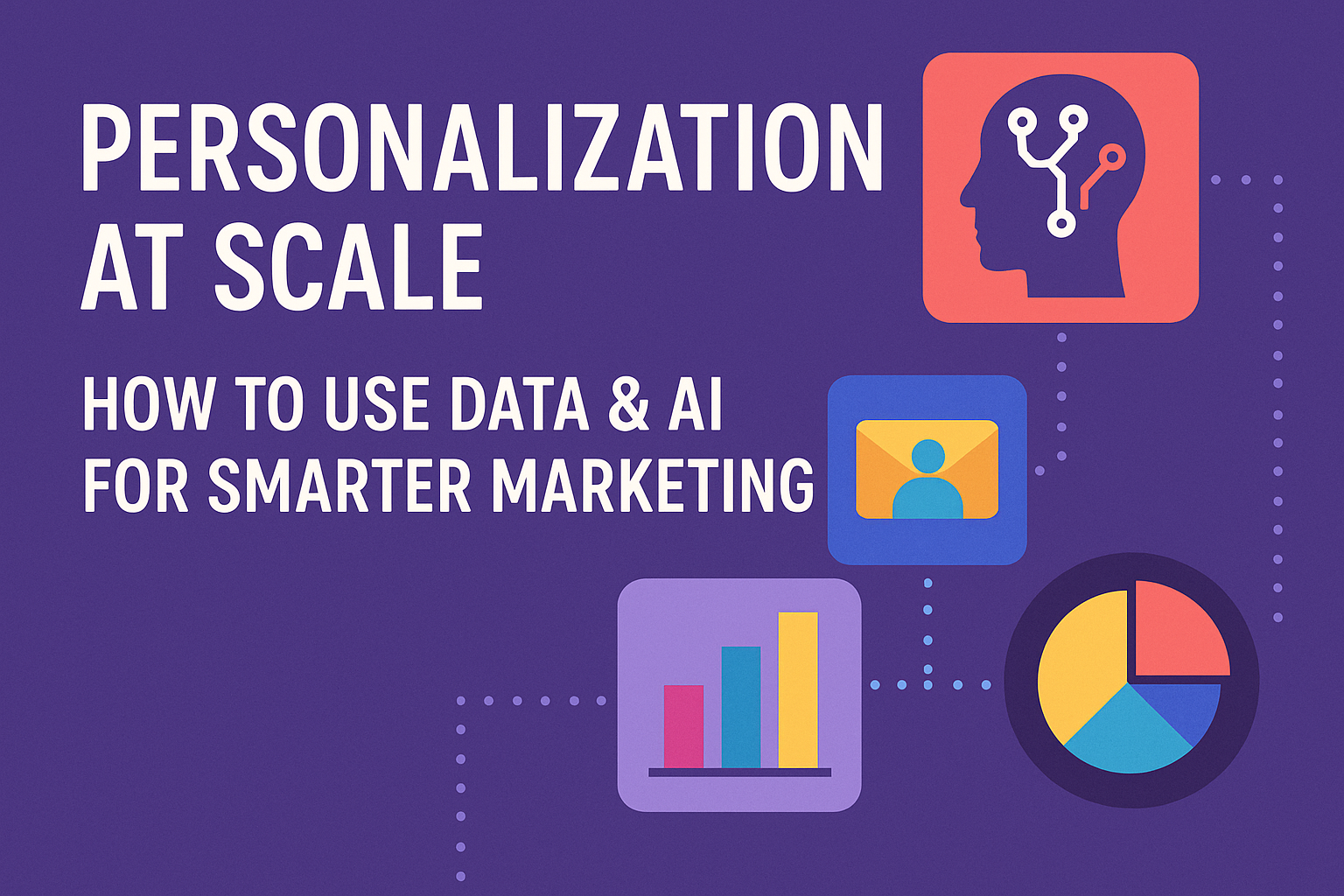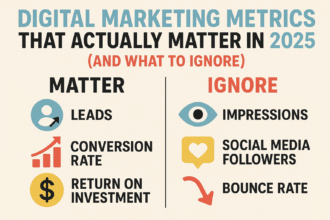Personalization at Scale: How to Use Data & AI for Smarter Marketing
Personalization at Scale: How to Use Data & AI for Smarter Marketing
Imagine opening your favorite streaming service and being presented with a wall of content you have zero interest in. Or visiting an e-commerce site only to be bombarded with ads for products you already bought. This is the digital world without personalization—a generic, one-size-fits-all experience that feels increasingly outdated and frustrating.
Today’s consumers don’t just appreciate personalization; they demand it. A recent 2025 report by McKinsey & Company found that 78% of consumers are more likely to make a repeat purchase from a brand that provides personalized experiences. Furthermore, businesses that leverage advanced personalization strategies report a 15-20% increase in marketing ROI and a 10-30% uplift in conversion rates.
But how do you move beyond simply inserting a customer’s first name in an email? The answer lies in the powerful fusion of data and artificial intelligence. True personalization at scale is the capability to deliver uniquely tailored experiences, content, and offers to individual customers across all touchpoints, in real-time, and automatically. It’s the holy grail of modern marketing, and this guide will provide the map to find it.
What is Personalization at Scale? Beyond the First Name
At its core, personalization at scale is the strategic use of technology—primarily AI and machine learning—to automate the delivery of unique experiences to large audiences without sacrificing relevance or a human touch.
It’s crucial to distinguish between different levels of personalization:
- Basic Personalization: This includes tactics like using a subscriber’s name in an email subject line (
{FNAME}) or showing their local weather. It’s a start, but it’s superficial. - Segmentation: Grouping audiences based on shared characteristics like demographics (e.g., “women aged 25-34 in New York”), past purchase behavior, or engagement level. This allows for more targeted messaging than a broadcast blast.
- Personalization at Scale (Hyper-Personalization): This is the apex. It uses real-time data and predictive AI to treat each customer as a segment of one. It doesn’t just react to past behavior; it anticipates future needs.
Key Characteristics of Personalization at Scale:
- Dynamic: Content and offers change based on real-time user behavior.
- Predictive: Uses AI to forecast what a customer might want next.
- Contextual: Considers the device, location, time of day, and current intent.
- Omnichannel: Delivers a consistent, personalized journey across email, web, mobile app, social media, and ads.
The Engine Room: Data as the Foundation
You cannot achieve personalization at scale without a robust data strategy. AI models are powerful, but they are useless—or worse, counterproductive—without clean, comprehensive, and actionable data.
Types of Data Required for Personalization
- First-Party Data: This is your most valuable asset. It’s data collected directly from your customers with their consent.
- Declared Data: Information users explicitly provide (e.g., name, email, preferences, size, birthday).
- Behavioral Data: Insights gathered from user interactions (e.g., pages viewed, products clicked, time on site, email opens, cart abandonment).
- Transactional Data: Purchase history, average order value, product returns.
- Second-Party Data: This is essentially another company’s first-party data that you acquire through a partnership. For example, a airline partnering with a hotel chain to share customer travel data for bundled offers.
- Third-Party Data: Data aggregated from numerous sources by a data provider. The use of this data has become significantly more complex and limited due to privacy regulations like GDPR and the deprecation of third-party cookies.
Building a Unified Customer View: The CDP
The critical step to activating this data is breaking down internal data silos. Marketing, sales, and service teams often operate on different systems, leading to a fragmented view of the customer.
A Customer Data Platform (CDP) is the technological solution for personalization at scale. A CDP ingests data from every source (website, CRM, email, point-of-sale, etc.), unifies it to create a single, persistent customer profile, and makes that profile accessible to other systems to execute personalized marketing campaigns.
The Brain: Artificial Intelligence and Machine Learning
Data tells you what happened. AI helps you understand why it happened and predict what will happen next. AI is the engine that makes personalization at scale not just possible, but automated and efficient.
Key AI Technologies Powering Personalization
- Machine Learning (ML) Algorithms: These algorithms analyze vast datasets to identify hidden patterns, segment audiences micro-moments, and predict future behavior like churn likelihood or lifetime value (LTV).
- Natural Language Processing (NLP): NLP allows AI to understand human language. It’s used for sentiment analysis of reviews and social media, powering chatbots for personalized support, and generating dynamic product descriptions.
- Recommendation Engines: The most recognizable form of AI-powered personalization. These engines use collaborative filtering (users like you also bought…) and content-based filtering (items similar to what you viewed…) to suggest highly relevant products, content, or services. Netflix and Amazon have perfected this.
- Predictive Analytics: This goes a step beyond recommendation engines. It can forecast individual customer needs before they even arise. For instance, a auto parts retailer might predict when a customer’s car will need new brake pads based on their purchase date and average mileage.
Implementing a Strategy for Personalization at Scale: A Practical Framework
Step 1: Audit and Consolidate Your Data
Identify all your data sources. Audit the quality, accuracy, and accessibility of this data. The goal is to begin centralizing it into a CDP or a centralized data warehouse.
Step 2: Define Clear Use Cases and Goals
Start with high-impact, achievable goals. Don’t try to personalize everything at once. Common starting points include:
- Reducing Cart Abandonment: Trigger an email or push notification with a personalized reminder and perhaps a limited-time offer.
- Upsell/Cross-sell: Recommend complementary products based on what’s in the cart or past purchases.
- Re-engagement Campaigns: Identify dormant users and target them with personalized win-back offers based on their past activity.
Step 3: Choose the Right Technology Stack
Your stack will likely include:
- CDP (e.g., Segment, mParticle, Tealium)
- CRM (e.g., Salesforce, HubSpot)
- Email Marketing Automation (e.g., Klaviyo, Braze, HubSpot)
- Web Personalization Tool (e.g., Dynamic Yield, Optimizely)
- Analytics Platform (e.g., Google Analytics 4)
Step 4: Build, Test, and Iterate
Implement your campaigns in a controlled manner. Use A/B testing to relentlessly test different personalization elements—from subject lines and product recommendations to entire website experiences. Analyze the results, learn, and optimize.
Real-World Case Studies: Personalization at Scale in Action
Case Study 1: Spotify’s “Wrapped” Campaign
The Strategy: Spotify leverages its immense wealth of first-party behavioral data (listening hours, top artists, favorite genres, discovery patterns) to create a hyper-personalized, year-in-review campaign for each of its hundreds of millions of users.
The AI/Data Use: Machine learning algorithms process petabytes of individual user data to generate unique stories and statistics for each listener.
The Result: The campaign generates massive organic social sharing, strengthens user emotional connection to the brand, and drives significant subscriber retention and acquisition. It’s a masterclass in using data to create a unique, shareable experience at an enormous scale.
Case Study 2: Starbucks’ Rewards Program
The Strategy: The Starbucks mobile app uses purchase history, location data, time of day, and even local weather to power its personalized offers and recommendations.
The AI/Data Use: Their deep learning engine analyzes individual behavior to predict what drink a customer might want. On a cold morning, it might push a offer for a hot oatmeal and latte combo. On a hot afternoon, it might suggest a refreshing cold brew.
The Result: This level of predictive personalization drives tremendous loyalty and frequency. According to their 2024 annual report, over 60% of all U.S. sales are generated through their loyalty program, directly attributable to their data-driven personalization strategy.
The Ethical Imperative: Balancing Personalization and Privacy
As marketers gain access to more data and powerful tools, the responsibility to use them ethically intensifies. Consumers are increasingly concerned about privacy, and regulations like GDPR, CCPA, and others enforce strict rules.
Principles for Ethical Personalization:
- Transparency: Be clear about what data you collect and how it will be used. Have a easily accessible privacy policy.
- Consent: Always obtain explicit and informed consent before collecting and using personal data, especially for sensitive information.
- Value Exchange: Make it worth the customer’s while. The value of the personalized experience must outweigh the perceived “cost” of their data.
- Anonymization: Where possible, use aggregated and anonymized data for analysis to protect individual identities.
- Control: Give users easy-to-find controls to adjust their privacy settings or opt out of data collection entirely.
The Future of Personalization at Scale: 2025 and Beyond
The evolution of personalization is moving at a breakneck pace. Key trends to watch include:
- Generative AI for Content Personalization: AI will dynamically generate unique marketing copy, product descriptions, and even video content tailored to individual users in real-time.
- The Rise of the Semantic Web: AI will get better at understanding user intent and the deeper meaning behind queries, moving beyond keywords to context.
- Hyper-Personalized Pricing and Promotions: Dynamic offers will become even more granular, with pricing and promotions tailored to an individual’s willingness to pay, predicted LTV, and current context.
- Voice and Visual Search Optimization: As search modalities diversify, personalization will extend into optimizing for voice assistants and image-based searches.
- AI-Powered Predictive Customer Service: AI will not only recommend products but also anticipate support issues, reaching out to customers with solutions before they even encounter a problem.
Conclusion: From Mass Marketing to Mass Personalization
The era of blasting generic messages to a broad audience is over. The future of marketing belongs to those who can harness the power of data and AI to create genuinely helpful, relevant, and human experiences for each individual customer—at scale.
The journey to personalization at scale is not a single project but a continuous evolution. It requires a cultural shift towards being customer-obsessed, data-informed, and agile. Start by auditing your data, defining a clear initial use case, and investing in the right technology stack. The brands that master this balance between art and science, between the human touch and algorithmic precision, will be the ones that build unbreakable loyalty and thrive in the decades to come.
Ready to start? Begin with a single touchpoint. Audit the data you have on your customer journey and identify one key area where a personalized interaction could significantly improve the experience. That first step is the most important one.
Frequently Asked Questions (FAQ)
1. What is the difference between segmentation and personalization at scale?
Segmentation involves grouping customers based on shared attributes (e.g., “all customers in California”). Personalization at scale, or hyper-personalization, treats each customer as a unique segment of one. It uses real-time data and AI to deliver individualized experiences, such as a website homepage that dynamically changes based on a specific user’s past behavior, predicted preferences, and current context.
2. How can I personalize without third-party cookies?
The decline of third-party cookies makes first-party data more critical than ever. Focus on building direct relationships with your customers. Use strategies like gated content, loyalty programs, newsletters, and value-exchange offers (e.g., a discount for a birthday) to encourage users to willingly share their data. A Customer Data Platform (CDP) is then essential for organizing and activating this consented first-party data across channels.
3. What are the biggest challenges in achieving personalization at scale?
The main challenges are:
- Data Silos: Data trapped in different departments and systems.
- Data Quality: Inaccurate or incomplete data leads to poor personalization.
- Technology Integration: Combining a complex stack of tools (CDP, CRM, etc.).
- Privacy Compliance: Navigating GDPR, CCPA, and other regulations.
- Organizational Culture: Needing buy-in across departments and building a data-driven mindset.
4. What is a CDP and do I need one for personalization?
A Customer Data Platform (CDP) is software that collects, unifies, and organizes customer data from all sources to create a single, persistent customer profile. This profile is then made available to other marketing and analytics systems. For any serious effort in personalization at scale, a CDP is not just recommended; it is often a foundational requirement to break down data silos and create a unified customer view.
5. How do you measure the ROI of personalization at scale?
ROI can be measured through key performance indicators (KPIs) that are directly influenced by personalized experiences. Track metrics such as:
- Conversion Rate: Lift in conversions on personalized landing pages or emails.
- Average Order Value (AOV): Increase in spend due to effective cross-selling.
- Customer Lifetime Value (LTV): Long-term value of engaged, personalized customers.
- Engagement Rates: Higher click-through rates (CTR) and open rates on personalized campaigns.
- Reduction in Churn: Lower attrition rates due to increased satisfaction.

![Discover how [Company] scaled to $1M ARR in just 12 months using growth marketing strategies—SEO, paid ads, and product-led growth](https://forthenextpro.com/wp-content/uploads/2025/09/20250903_1115_Rapid-Growth-Success_simple_compose_01k47h40c8ekp8gp0ssww9czhv-150x150.png)






